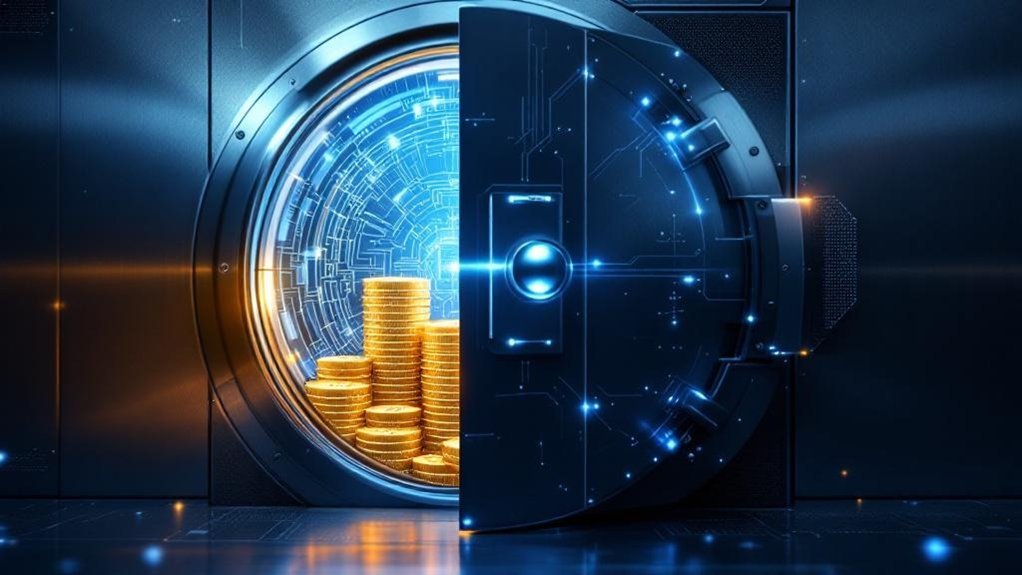A crypto savings account is like a regular bank account, but for digital assets. Users deposit their cryptocurrency with a platform, which then lends those assets to borrowers and shares the interest with depositors. These accounts can offer higher yields than traditional savings accounts, especially for stablecoins. While the concept mirrors old-school banking, there’s a catch – no FDIC insurance here. The crypto world’s version of earning passive income comes with its own unique twists and turns.

A crypto savings account represents a digital-age twist on traditional banking, letting crypto holders earn passive income on their digital assets.
These accounts, typically offered by crypto exchanges and DeFi platforms, merge old-school savings concepts with blockchain technology. Think of it as your grandfather’s savings account – except way more interesting and potentially lucrative.
The mechanics are surprisingly straightforward. Users deposit their cryptocurrency with a platform, which then puts those digital assets to work. The platforms generate returns through various income-generating activities, including lending, investments, and staking mechanisms.
Deposit your crypto, and let the platform do the heavy lifting. It’s digital money making more digital money.
The platform lends out these assets to borrowers – could be individuals, companies, or even other crypto protocols desperately seeking liquidity. In return, account holders get a slice of the interest pie. It’s like being a mini-bank, minus the stuffy suits and marble countertops.
The cryptocurrency options are pretty diverse. Stablecoins like USDC and USDT are popular choices, mainly because their values don’t bounce around like a kangaroo on caffeine. Most platforms partner with trusted crypto custodians to secure and manage clients’ digital assets.
Bitcoin and Ethereum are also common options, though their volatile nature means interest rates can be a wild ride. Different platforms support different coins – some stick to the basics, while others offer a virtual buffet of crypto options. Users can choose between flexible accounts that allow withdrawals anytime or fixed-term accounts with higher returns.
Here’s where things get interesting: the interest rates. Traditional banks offer returns so low you need a microscope to see them.
Crypto savings accounts? They’re in a whole different league. Annual Percentage Yields can be substantially higher, though they fluctuate based on market conditions, cryptocurrency type, and how much you’ve got stashed away.
Of course, these juicy returns come with their own set of risks – these aren’t your FDIC-insured accounts.
The whole system relies on the platform’s security measures. Your crypto gets transferred from your personal wallet to their custody, protected by fancy encryption and cold storage systems.
It’s like putting your digital gold in someone else’s ultra-secure vault – and hoping they’re as reliable as they claim to be.
Frequently Asked Questions
How Quickly Can I Withdraw My Crypto From a Savings Account?
Withdrawal times from crypto savings accounts vary wildly.
Some platforms process requests instantly, while others enforce mandatory lock-up periods. Network congestion can slow things down.
Most savings accounts require an unstaking period – could be hours, days, or weeks. No shortcuts here. Verification steps and security protocols add extra time too.
Bottom line: instant access isn’t guaranteed with crypto savings.
Are Crypto Savings Accounts Available in All Countries Worldwide?
Crypto savings accounts aren’t available everywhere – not even close.
Regulatory hurdles and unclear laws in many countries make it complicated. Some places like Switzerland and Singapore? They’re all in.
But others flat-out ban these accounts.
Tax policies also play a huge role.
Countries with crypto-friendly regulations and stable economies tend to have better access.
Developing nations? Often left in the digital dust.
What Happens to My Crypto if the Platform Goes Bankrupt?
If a crypto platform goes bankrupt, users’ assets could be frozen indefinitely.
No FDIC insurance here, folks. Recovery? That’s a big maybe. Legal proceedings drag on for months, even years.
Custodial platforms can lose everything – poof, gone. Some bankruptcies end in total losses, others in partial recovery.
The crypto world’s still figuring this stuff out, and bankruptcy courts are scratching their heads too.
Can I Earn Interest on Multiple Cryptocurrencies Simultaneously?
Yes, users can earn interest on multiple cryptocurrencies at once.
Major platforms like Binance and YouHodler support dozens of digital assets – each earning its own interest rate independently. Bitcoin, Ethereum, stablecoins – they all tick away generating yields simultaneously.
Rates vary wildly though, from a measly 0.5% to a juicy 18% APY. Different coins, different rates, same account dashboard. Simple as that.
Do I Need to Maintain a Minimum Balance in My Crypto Savings Account?
Minimum balance requirements vary wildly between crypto platforms.
Some demand nothing, others get picky. Flexible savings accounts typically skip the minimums but offer lower yields.
Locked accounts? Different story. They often require minimum deposits and lock-up periods – but compensate with juicier rates.
The trade-off is simple: more restrictions generally mean better returns. Watch those terms and conditions though, they’re sneaky.
